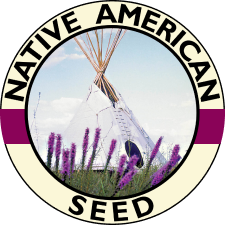Also called 'icecream grass' by ranchers because livestock like it so much. High in protein. This relative of corn makes tall, dense thickets when it finds the right conditions to grow, and can be useful as a boundary between one part of your landscape and another. When we lived in North Texas, we used it along the western border of our vegetable garden, in a low place where it enjoyed the extra moisture and poor drainage. The blooms and seeds are very interesting, and wildlife loves the plant as a whole! In tamer landscapes, you'll want to cut back the old leaves before the new ones start to appear in the Spring. But, be careful to check for butterfly eggs and pupae before you dispose of the old leaves and stems. Eastern Gamagrass is a larval food of choice for the Bunchgrass Skipper butterfly.
Also available in Live Roots direct from our farm!
The Natives are Friendly
by Znobia Wootan
As I look up the South Llano River, I marvel at the gold and yellow lining the banks. In just two years without any grazing pressure, volunteers of Eastern Gamagrass now line the bank on my side of the river. Eastern Gamagrass, Tripsacum dactyloides, grows from eastern U.S. coast into Iowa, Kansas, Colorado and south to Mexico. Bill has seen it on rivers south of Monterrey, Nuevo Leon. This perennial, warm-season grass grows in a wide range of conditions from sun to part shade and medium to moist soils. Having deep roots, often reaching down 20 feet, helps Gamagrass live during times of drought. Tuff-rooted corms at the surface act as anchors in conjunction with dense, long leaf blades during times of flooding. Eastern Gamagrass is now controlling extensive erosion found along steep cut-banks on my side of the river. As the grass thickens and spreads, the steep banks will become even more stable in future years.
Eastern Gamagrass can easily out-survive many non-native grasses in times of drought, whether as a rangeland grass, food source for wildlife, or used in landscapes. It is one of the most productive and nutritious hay producing grasses known to planet Earth. Some ranchers are now using it for hay production in the organic beef market. Since it has no known pests and grows abundantly without fertilizers, this translates into not using petro-based forms of fertility or pesticides. Cattle find this grass irresistible. It was mostly grazed to extinction before proper range management practices were discovered. I still question whether we have yet established proper grazing management strategies to fully appreciate low-input, sustainable, native prairies which once abounded our nation. It all boils down to understanding ‘carrying capacity’.
As a landscape plant, Eastern Gamagrass is useful to stand alone as a focal interest point, in free-form colonies, or buffer-screens like pampas grass. This tall thick clump grass is usually 2-3 ft high with wide blades. The dense foliage provides much needed cover and habitat for birds and small mammals and is a larval food source for many species of butterflies and the rare moth amphipoea erepta. Bill has a patch around his frog pond that attracts dragonflies. Eastern Gamagrass is an ancestor to our present day annual food staple called corn. Upon close observation, the interesting 4-5 foot height seed stems offer amazing resemblances to silks and tassels found on corn. When ripe, Eastern Gama produces single lines of large, hard, yellowish corn kernels stacked end to end. As you can imagine turkey, quail, dove and deer love them. Eastern Gamagrass is a native that adds sustainability, diversity and enjoyment to any landscape.











































